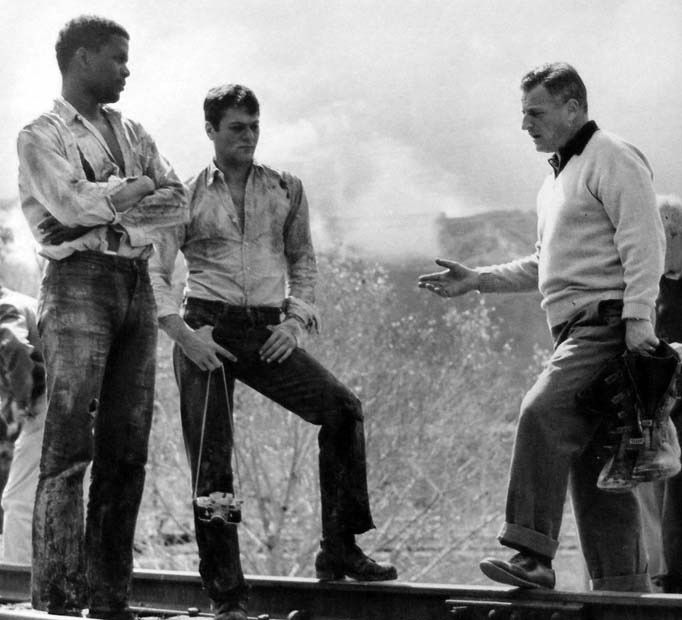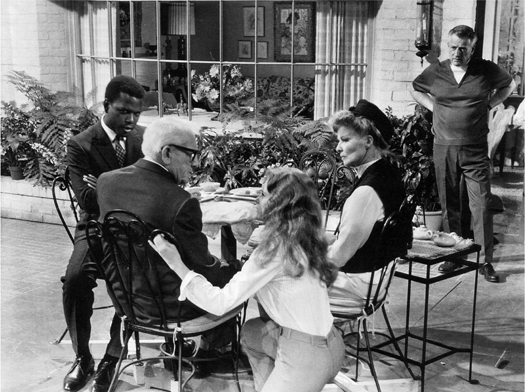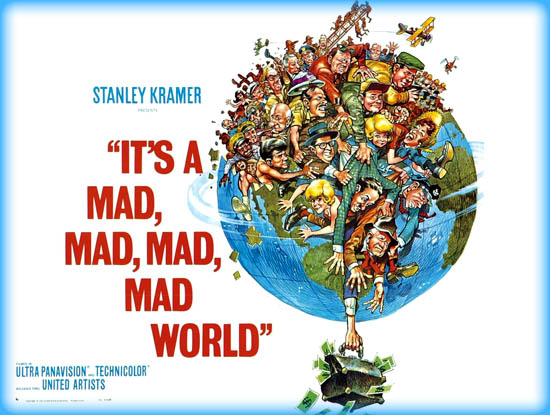Want to know the best Stanley Kramer movies? How about the worst Stanley Kramer movies? Curious about Stanley Kramer box office grosses or which Stanley Kramer movie picked up the most Oscar® nominations? Need to know which Stanley Kramer movie got the best reviews from critics and audiences and which got the worst reviews? Well, you have come to the right place….because we have all of that information.
Stanley Kramer (1913-2001) was a 9-time Oscar® nominated American director and producer. Kramer was responsible for making many of Hollywood’s most famous “message films”. As an independent producer and director, he brought attention to topical social issues that most studios avoided. His IMDb page shows over 61 producing & directing credits from 1942 to 1979. This page will rank Stanley Kramer movies from Best to Worst in six different sortable columns of information. Television shows, shorts, cameos, uncredited roles, and movies that were not released in North American were not included in the rankings. This page comes from a request by Greg.

Stanley Kramer Movies Ranked In Chronological Order With Ultimate Movie Rankings Score (1 to 5 UMR Tickets) *Best combo of box office, reviews and awards.
Year
Movie (Year)
Rating
S
Year Movie (Year) Rating S
1952
High Noon (1952)
AA Best Picture Nom
AA Best Picture Nom![]()
1954
The Caine Mutiny (1954)
AA Best Picture Nom![]()
1961
Judgment at Nuremberg (1961)
AA Best Picture Nom
AA Best Director Nom![]()
1967
Guess Who's Coming to Dinner (1967)
AA Best Picture Nom
AA Best Director Nom![]()
1963
It's a Mad Mad Mad Mad World (1963)
![]()
1958
The Defiant Ones (1958)
AA Best Picture Nom
AA Best Director Nom![]()
1949
Champion (1949)
![]()
1959
On the Beach (1959)
![]()
1953
The Wild One (1953)
![]()
1965
Ship of Fools (1965)
AA Best Picture Nom![]()
1950
Cyrano de Bergerac (1950)
![]()
1955
Not as a Stranger (1955)
![]()
1942
The Moon and Sixpence (1942)
![]()
1960
Inherit the Wind (1960)
![]()
1951
Death of a Salesman (1951)
![]()
1949
Home of the Brave (1949)
![]()
1969
The Secret of Santa Vittoria (1969)
![]()
1957
The Pride and the Passion (1957)
![]()
1963
A Child Is Waiting (1963)
![]()
1950
The Men (1950)
![]()
1952
The Member of the Wedding (1952)
![]()
1962
Pressure Point (1962)
![]()
1952
My Six Convicts (1952)
![]()
1952
The Sniper (1952)
![]()
1953
The Juggler (1953)
![]()
1953
The 5,000 Fingers of Dr. T. (1953)
![]()
1952
The Happy Time (1952)
![]()
1952
Eight Iron Men (1952)
![]()
1948
So This Is New York (1948)
![]()
1971
Bless the Beasts & Children (1971)
![]()
1952
The Four Poster (1952)
![]()
1973
Oklahoma Crude (1973)
![]()
1979
The Runner Stumbles (1979)
![]()
1970
R.P.M. (1970)
![]()
1977
The Domino Principle (1977)
![]()

Stanley Kramer Movies Can Be Ranked 6 Ways In This Table
The really cool thing about this table is that it is “user-sortable”. Rank the movies anyway you want.
- Sort Stanley Kramer movies by his co-stars
- Sort Stanley Kramer movies by adjusted domestic box office grosses using current movie ticket cost (in millions)
- Sort Stanley Kramer movies by yearly domestic box office rank
- Sort Stanley Kramer movies how they were received by critics and audiences. 60% rating or higher should indicate a good movie.
- Sort by how many Oscar® nominations and how many Oscar® wins each Stanley Kramer movie received.
- Sort Stanley Kramer movies by Ultimate Movie Rankings (UMR) Score. UMR puts box office, reviews, and awards into a mathematical equation and gives each movie a score.
*Movies made between 1942 and 1954 were only produced by Stanley Kramer. Movies made from 1955 and 1979 were produced and directed by Kramer.
| R | Movie (Year) | UMR Co-Star Links | Adj. B.O. Worldwide (mil) | Review | Oscar Nom / Win | UMR Score | ||||
|---|---|---|---|---|---|---|---|---|---|---|
| R | Movie (Year) | UMR Co-Star Links | Actual B.O. Domestic (mil) | Adj. B.O. Domestic (mil) | Adj. B.O. Worldwide (mil) | B.O. Rank by Year | Review | Oscar Nom / Win | UMR Score | S |
| 1 | High Noon (1952) AA Best Picture Nom AA Best Picture Nom |
Gary Cooper & Grace Kelly |
9.40 | 201.8 | 201.80 | 12 | 92 | 07 / 04 | 99.7 | |
| 2 | The Caine Mutiny (1954) AA Best Picture Nom |
Humphrey Bogart & José Ferrer |
20.40 | 522.2 | 522.20 | 4 | 85 | 07 / 00 | 99.3 | |
| 4 | Judgment at Nuremberg (1961) AA Best Picture Nom AA Best Director Nom |
Spencer Tracy & Marlene Dietrich |
11.30 | 179.2 | 179.20 | 19 | 86 | 11 / 02 | 99.2 | |
| 3 | Guess Who's Coming to Dinner (1967) AA Best Picture Nom AA Best Director Nom |
Spencer Tracy & Sidney Poitier |
52.50 | 509.8 | 509.80 | 4 | 71 | 10 / 02 | 98.6 | |
| 5 | It's a Mad Mad Mad Mad World (1963) | Spencer Tracy & Milton Berle |
45.90 | 627.6 | 627.60 | 2 | 76 | 06 / 01 | 97.6 | |
| 6 | The Defiant Ones (1958) AA Best Picture Nom AA Best Director Nom |
Tony Curtis & Sidney Poitier |
7.90 | 153.9 | 153.90 | 27 | 77 | 09 / 02 | 96.8 | |
| 9 | Champion (1949) | Kirk Douglas & Arthur Kennedy |
5.80 | 159.4 | 159.40 | 40 | 83 | 06 / 01 | 96.4 | |
| 7 | On the Beach (1959) | Gregory Peck & Ava Gardner |
13.60 | 267.2 | 432.80 | 17 | 71 | 02 / 00 | 95.6 | |
| 11 | The Wild One (1953) | Marlon Brando & Lee Marvin |
8.60 | 169.1 | 169.10 | 25 | 74 | 00 / 00 | 93.0 | |
| 8 | Ship of Fools (1965) AA Best Picture Nom |
Vivien Leigh & Simone Signoret |
9.50 | 109.0 | 109.00 | 28 | 76 | 08 / 02 | 92.5 | |
| 12 | Cyrano de Bergerac (1950) | José Ferrer | 5.40 | 132.9 | 132.90 | 50 | 78 | 01 / 01 | 91.3 | |
| 10 | Not as a Stranger (1955) | Olivia de Havilland & Frank Sinatra |
20.30 | 458.4 | 458.40 | 6 | 56 | 01 / 00 | 90.4 | |
| 14 | The Moon and Sixpence (1942) | George Sanders | 3.40 | 138.9 | 138.90 | 78 | 64 | 01 / 00 | 86.3 | |
| 13 | Inherit the Wind (1960) | Spencer Tracy & Fredric March |
3.50 | 59.6 | 97.30 | 71 | 86 | 04 / 00 | 86.0 | |
| 15 | Death of a Salesman (1951) | Fredric March & Kevin McCarthy |
3.40 | 80.6 | 80.60 | 107 | 74 | 05 / 00 | 84.4 | |
| 17 | Home of the Brave (1949) | Lloyd Bridges | 3.60 | 98.7 | 98.70 | 100 | 66 | 00 / 00 | 81.0 | |
| 16 | The Secret of Santa Vittoria (1969) | Anthony Quinn & Anna Magnani |
7.70 | 63.8 | 63.80 | 36 | 75 | 02 / 00 | 80.9 | |
| 20 | The Pride and the Passion (1957) | Cary Grant & Frank Sinatra |
8.60 | 179.8 | 179.80 | 25 | 39 | 00 / 00 | 80.6 | |
| 18 | A Child Is Waiting (1963) | Burt Lancaster & Directed by Cassavetes |
2.50 | 34.0 | 34.00 | 79 | 81 | 00 / 00 | 77.9 | |
| 19 | The Men (1950) | Marlon Brando & Directed by Fred Zinnemann |
2.40 | 59.4 | 59.40 | 124 | 72 | 01 / 00 | 77.7 | |
| 21 | The Member of the Wedding (1952) | Julie Harris & Directed by Fred Zinnemann |
2.00 | 43.0 | 43.00 | 156 | 70 | 01 / 00 | 71.5 | |
| 22 | Pressure Point (1962) | Sidney Poitier & Bobby Darin |
2.30 | 35.4 | 35.40 | 94 | 73 | 00 / 00 | 70.9 | |
| 23 | My Six Convicts (1952) | Millard Mitchell & Harry Morgan |
3.10 | 65.3 | 65.30 | 115 | 63 | 00 / 00 | 70.7 | |
| 24 | The Sniper (1952) | Adolphe Menjou | 1.50 | 31.1 | 31.10 | 181 | 72 | 00 / 00 | 68.0 | |
| 25 | The Juggler (1953) | Kirk Douglas & Milly Vitale |
2.70 | 53.4 | 53.40 | 138 | 62 | 00 / 00 | 64.9 | |
| 27 | The 5,000 Fingers of Dr. T. (1953) | Written by Dr. Seuss | 2.00 | 38.6 | 38.60 | 168 | 65 | 00 / 00 | 61.9 | |
| 26 | The Happy Time (1952) | Charles Boyer | 0.90 | 18.8 | 18.80 | 207 | 71 | 00 / 00 | 61.6 | |
| 28 | Eight Iron Men (1952) | Lee Marvin & Richard Kiley |
1.90 | 41.5 | 41.50 | 162 | 60 | 00 / 00 | 56.3 | |
| 29 | So This Is New York (1948) | Henry Morgan | 1.10 | 32.6 | 32.60 | 169 | 62 | 00 / 00 | 54.3 | |
| 30 | Bless the Beasts & Children (1971) | Bill Mumy | 2.00 | 14.1 | 14.10 | 122 | 66 | 01 / 00 | 52.2 | |
| 31 | The Four Poster (1952) | Rex Harrison | 1.10 | 24.5 | 24.50 | 192 | 61 | 01 / 00 | 48.9 | |
| 32 | Oklahoma Crude (1973) | George C. Scott & Faye Dunaway |
7.60 | 50.3 | 50.30 | 45 | 51 | 00 / 00 | 43.7 | |
| 33 | The Runner Stumbles (1979) | Dick Van Dyke | 2.10 | 9.9 | 9.90 | 118 | 56 | 00 / 00 | 28.1 | |
| 34 | R.P.M. (1970) | Anthony Quinn & Ann-Margret |
1.30 | 9.8 | 9.80 | 132 | 48 | 00 / 00 | 13.6 | |
| 35 | The Domino Principle (1977) | Gene Hackman & Richard Widmark |
4.60 | 24.2 | 24.20 | 86 | 41 | 00 / 00 | 11.6 |
Possibly Interesting Facts About Stanley Kramer
1. Stanley Earl Kramer was born in Manhattan, New York in 1913. His mother worked at a New York office of Paramount Pictures, while uncle, Earl Kramer, worked in distribution at Universal Pictures.
2. Stanley Kramer served in the Army Signal Corps during World War II, making training films. He finished the war with the rank of first lieutenant.
3. Stanley Kramer produced six Best Picture Oscar® nominees: High Noon (1952), The Caine Mutiny (1954), The Defiant Ones (1958), Judgment at Nuremberg (1961), Ship of Fools (1965) and Guess Who’s Coming to Dinner (1967).
4. Stanley Kramer was going to name his child after Spencer Tracy, but when the baby turned out to be a girl, he named her after Katharine Hepburn. Hepburn was also her godmother. An avid Yankee fan, he could name players on every team over the decades. In fact, he named his first daughter, actress Casey Kramer, after player/manager, Casey Stengel.
5. Director Steven Spielberg described Stanley Kramer as an “incredibly talented visionary”, and “one of our great filmmakers, not just for the art and passion he put on screen, but for the impact he has made on the conscience of the world.”
Check out Stanley Kramer’s career compared to current and classic actors. Most 100 Million Dollar Movies of All-Time.
Academy Award® and Oscar® are the registered trademarks of the Academy of Motion Arts and Sciences. Golden Globes® are the registered trademark and service mark of the Hollywood Foreign Press. Emmy® is a registered trademark.


IMDB credits Stan with 22 awards/37 noms awards which was good for times when formal accolades were not dished out as if they grew all the year round on a Hollywood back lot as seems to be the case today. Celebrity Net Worth puts his value at the time of his death in 2019 dollars at just under $30 million.
I like the miniature still above with Stanley in the background looking for all the world as the aggressive Mike Hammer about to break up a den of thieves! “Voted Up”! Note Micky Spillane played the part of an author in an 1974 episode of Columbo [“Publish or Perish] in which he was murdered by a Columbo repetive guest murderer Jack Cassidy I though that Mickey too bore a resembalance to Kramer in terms of ruggedness and pugalisitic appearance.
KRAMER FILMS THAT I HAVE SEEN -Producer and Director
Not as a Stranger
Pride and the Passion – awful!
On the Beach – Astaire breaking into ‘acting’
Inherit the Wind-like Fred Eugene tries his hand at acting
Judgment at Nuremberg
Ship of Joels – it did not impress the great David Shipman
Guess Who’s Coming to Dinner
The Domino Principle
The Runner Stumbles – a serious Dick Van Dyke but “A silly film” – Roger Ebert
PRODUCER/ASSOCIATE PRODUCER ONLY
The Men-good Brando debut but depressing and dated.
Death of a Salesman -very- ‘dry goods’
High Noon-one of my all-time fave westerns
The Wild One: boring today.
Caine Mutiny – my 2nd fave Kramer movie
A Child is Waiting – Burt and Judy: an unusual teaming in a dramatic film
Invitation to the Gunfighter-Stan uncredited
The Moon and Sixpence- my own fave Kramer film
Champion-makes Rocky look like kids pretending to be boxers. In my view matched by only Robert Ryan’s The Setup/Garfield’s Body and Soul/ and DeNiro/Scorsese’s Raging Bull
Hey Bob….I really enjoyed your mini-reviews on the ones you have seen. No thoughts on Not As A Stranger…..that is a movie that confuses me….such a great cast for a movie nobody seems to remember. I have not seen The Moon and Sixpence…..but seeing it is your favorite is interesting…I have also not seen Champion…..but I want to. Keep up the mini-reviews…fun to read. Good stuff.
HI BRUCE:
Thanks for the further feedback. I remember Not as a Stranger well and it is one of my own fave Kramer and Mitchum movies.
Sinatra although he got equal star billing after Olivia DeHavilland and Big Bob had a small role in it and disappeared half way through the film if I remember correctly.
Regarding screen time it was Mitchum’s film. The author of the book Morton Thompson was very popular at the time.
Hey Bob. Thanks for the breakdown on not as a stranger. The more I hear and read about it, the more I think I need to see it. Good stuff.
“CHANGING AMERICA: THE MOVIES [Newsweek article]
By the end of the 1960s tastes in film too had rapidly been changing. For example with the real-life horrors of the Vietnam war unfolding nightly across a volatile America’s television screens, by comparison the Brando/Marvin kind of character that we saw in The Wild One looked tame rather than a “tearaway” national menace.
And the War killed off in the sentiments of audiences for the comparatively bland image that the Cary Grant figure projected on the screen as that persona was no longer comforting when audiences could see on television the devastating effects that The War was having on family and other human relationships at home and abroad.
Children fleeing in terror from exploding bombs made Grant’s placid world up there on the screen seem TOO unreal. John Wayne’s implication in The Green Berets that the Viet Cong shooting back at the Americans in A WAR SITUATION was IN ITSELF an illustration that the Cong were evil killers was very thin though the movie itself was popular because of Wayne’s still strong personal following.
However in the seventies Wayne’s films started to do less well at the box office and 1971’s Patton, with all Patton’s flaws highlighted, suggested that the day of the screen’s super-heroic patriotic “John Wayne generals” had come to an end. Cary Grant may have already “got the message” ahead of time because he retired in the mid-1960s when he was still popular.
Brando [younger than the other two of course] survived and although some film observers suggest that that was because he was perceived as the ‘pathfinder’ of modern American acting styles I feel that it was more to do with the very contemporary-world Godfather and the modern craving for erotic films like Last Tango in Paris saving his bacon; in the 60s his career had been going steadily down the tubes and in Hollywood where he had long been regarded by numerous people as an ‘interloper’ he had as many enemies as he had admirers.
In short whilst changing tastes closed the era of the Old Hollywood of Grant and Wayne they probably kept afloat others like Brando and George C Scott for a while longer.”
Hey Bob…good thoughts on Wayne, Kramer and Brando. While I agree his The Wild One is somewhat dated…it is one of my favorite Brando roles. I agree about your changing tastes thoughts. Though not thinking Brando and Scott stayed afloat too much longer than Wayne. As always thanks for sharing these thoughts.
HI BRUCE: Thanks for the triple feedback. I think the longevity point was that whilst Brando’s run of big box office hits ended with Superman and Apocalypse Now in 1978 and 1979 the year in which The Duke died Marlon’s status and influence as a perceived ‘Great’ American acting icon kept him afloat for another 20 years during which he was offered big money for very little [Joel’s gripe!] and his final film in 2001 in which he was still getting star billing with important modern actors like DeNiro and Edwrd Norton crashed your magical 100 million dollar barrier.
That contrasts with Marlon’s plight in the 1960s when it looked as if he was a complete gonner as a major star though even before Last Tango/Godpop Variety alone did predict he would survive because he was in their words “THE American actor” for many other people at that time.
I have a theory which the remarkable come-backs of Sinatra in the 1950s and Brando in the early 1970s does support in my opinion: if you are a Great in Hollywood and hit bottom but rise to the top again you have a licence to simply “BE” without having to do much to maintain your renewed former status [a bit like the Gabors and all that untalented “famous for being famous” clique who survive on hype without producing anything artistically or at the box office].
Guys like Hirsch don’t like it [he in Marlon’s case and I in respect of the Gabor types] but that’s showbusiness. As Jeffrey Jones as Emperor Joseph 2nd kept saying in Amadeus when courtiers kept coming to him with complaints about unfairmness in society “Well there it is!”; and he simply turned his back on them and walked away. He would have had little time for Joel’s complaints about Marlon when others like Archibald and Randy Scott were also rollin about in millions.
Hey Bob…save this comment. I agree with almost this entire comment. Even the part about Mr, Hirschhorn.
I always thought that with his rugged and pugnacious appearance Stanley looked more like a traditional Hollywood screen tough guy than a director; and indeed it occurred to me that he might well have suited the role of Mickey Spillane’s Mike Hammer [played on screen by for example Ralph Meeker in Kiss Me Deadly and Biff Elliot in I the Jury] so that in my own mind I would nickname Stan “Mike Kramer!” It has been said about Mickey’s Hammer “His love for his secretary Velda is outweighed only by his willingness to kill a killer.” Sound like Laddie’s type of guy!
I Have seen 18 of the movies with which Stan is associated – see Part 3- as a director and/or producer. That’s again a bit behind Queen Flora’s 21; but it’s good for ME because when Stan was in his heyday I was more into escapism cowboys and Indians B flicks than the kind of strong meat [for those times] that Stanley fed us and indeed he was known as the “king of the message films”.
However possibly Stan’s reputation as a “message promoter” has today dimmed a bit. For example contemporary critics/historians [who are maybe not as easily taken in by historical movie sentimentality as the likes of Joel Hirschhorn] have thought that although he was truly sympathetic on racial issues [as per The Defiant Ones] Stan’s Guess Who’s Coming to Dinner went too far in that it was actually patronizing towards the African American community and America’s working class. Often mentioned is the scene where Tracy doing his Great American Liberal act suggests that it is a marvel that a humble [black] postman should produce such a marvelous son as the Poitier character.
It was in fact only in the 1970s that I caught up with Brando’s debut film The Men [aka Battle Stripe] on a TV rerun; and today it and Marlon’s Wild One seems very dated – and see in Part 2 what one historian writing in the late 1980s about “Changing America” opined in relation to movies –
Hey Bob. Thanks for the feedback on Stanley Kramer. Tally count: Flora 21, you 18 and me 12. You almost topped Flora…very impressive. I agree…he looks like a leading man versus a producer and a director. Maybe with all the social injustice these days, his movies will get the spotlight shined on them again. I have not seen his The Men with Brando…but it is in the house to be watched. Good stuff.
Great Director and excellent UMR page.
Thx
Mike
Thank you Mike. For some reason I always get my Stanleys mixed up…Donen and Kramer.
I have seen 21 Stanley Kramer movies, including the top 14.
The HIGHEST rated movie I have seen is High Noon.
The highest rated movie I have NOT seen is Death of a Salesman.
The LOWEST rated movie I have seen is Eight Iron Men.
Favourite Stanley Kramer Movies:
High Noon
The Caine Mutiny
Guess Who’s Coming to Dinner
It’s a Mad, Mad, Mad, Mad World
The Defiant Ones
Ship of Fools
Not as a Stranger
Other Stanley Kramer Movies I Have Seen:
Judgement at Nuremberg
On the Beach
Champion
The Wild One
Cyrano de Bergerac
Inherit the Wind
The Secret of Santa Vittoria
The Moon and Sixpence
The Men
The Member of the Wedding
My Six Convicts
The Juggler
Eight Iron Men
The Sniper
Hey Flora….thanks for checking out our Stanley Kramer page. Tally count: 21 for you and 12 for me. He directed some of your favorites…Widmark and Peck. I have seen all of your favorites with the exception of Not As A Stranger. Not As A Stranger is a movie that has always confused me….it has a legendary cast, it made a boatload of money….but is rarely discussed. It would seem a movie starring Mitchum, Marvin and Sinatra would be one that people would talk about.
Surprised that Judgement at Nuremberg is not on your favorites list. My mom still is not over the ending of On The Beach…and it is now over 60 years old. Good stuff as always.